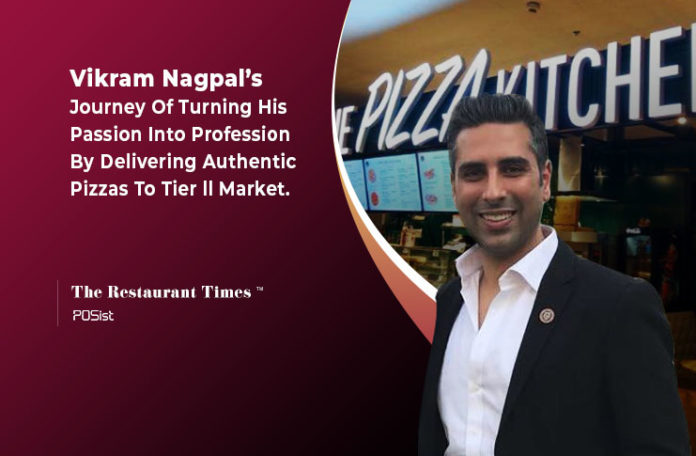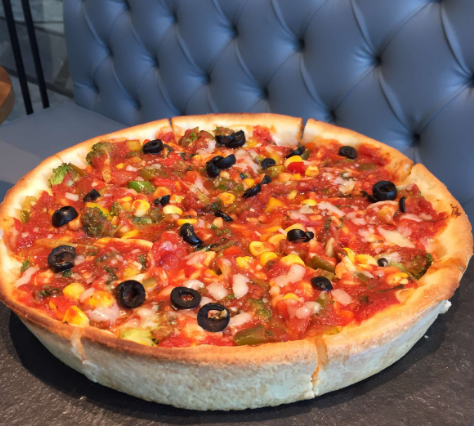Vikram Nagpal, an ardent coffee drinker, is a strong entrepreneurship professional who holds a Cornell Executive Management Program focused on Executive Management from Cornell University, USA. He started his journey in the F&B Industry as the first sub-franchisee of The Coffee Bean & Tea Leaf for Punjab and Chandigarh. Nagpal’s idea was to turn his passion into a profession with the help of an existing International brand to know about the contours of the business before investing in creating his own brand. It has been more than six years for him in the industry. He began with The Pizza Kitchen in April 2019 in Chandigarh.
In Conversation With Vikram Nagpal of The Pizza Kitchen
In an exclusive conversation with The Restaurant Times, Vikram Nagpal talks of his journey in the industry, the story behind The Pizza Kitchen, major hurdle in Tier ll market and a lot more.
About The Pizza Kitchen
The idea for The Pizza Kitchen (TPK) was conceived over a slice of pizza from one of our current competitors for lunch in our office. Our meal, we realised, was barely filling for a Pepperoni and Cheese pizza slice. Nagpal determined that he had to delve deeper into the science and art of creating an Authentic Pizza Experience made with the best possible ingredients available from around the world. He worked on his idea for more than fifteen months before launching a lean start-up model which failed and evolved several times going through a series of real-time product trials before they had a viable concept.
The USP of The Pizza Kitchen is the authenticity of the products and use of high quality imported ingredients from various countries in Europe.
One of the hot-selling pizzas at TPK is the NewYork style pizzas, offered in huge single slices, dripping with cheese and its ingredients are sourced from Italy and Switzerland. Some others include Pepperoni, Ham & Rocket and Mushroom Overload Pizza.
Major Hurdle Operating In Tier ll Market
Running a restaurant is hard work. Between staffing problems, food safety concerns and keeping customers happy, there are always new challenges in this ever-changing business landscape.
According to Nagpal, they are facing a challenge differentiating their premium product in the market which is adversely affecting their returns. This is because the brand currently has a very high Cost of Goods Sold (CoGS) on their sales. Cost of Goods Sold describes the amount of money a restaurant spends on supplies and food ingredients- such as beverages, seasonings, meats, fruits and vegetables used to prepare menu items for sale. According to the Food Service Warehouse, COGS should ideally account for no more than 31% of your sales.
While customers are increasingly concerned about price, they also expect more for less. In particular, customers are increasingly demanding healthier and more sustainable food.
That trend adds up to higher costs for restaurants.
Striking the right balance can be a very tricky equation. Nagpal has not been able to overcome this hurdle yet as they will have to slowly and gradually educate their guests about how their product is different from the rest of the competition and why they may command a slightly higher price for selling a premium product and experience.
General Customer Perception and Trends In Chandigarh
The general public and your ideal customer are equally influenced by your brand, and it is your brand that drives customer perception. Nagpal mentions that in the F&B industry, customers today are spoilt for choice in every city.
“The excitement dies down very soon as they find out that most new places are only finer replicas of what is already available. We rarely see a new outlet with a different meaning and purpose in this entire ecosystem,” says Nagpal.
According to Nagpal, the current trends in the food and beverage industry in Chandigarh include cloud kitchens, coffee shops and fast-casual restaurants. It has been noted that the number of dine-in customers has decreased significantly over the last few years, with customers mostly opting for home delivery of food. The cloud kitchen concept has gained momentum. Apart from the cloud kitchens, the coffee shops are also gaining steam. Gen Z is bringing in a new wave of coffee drinkers and their preferences are far different from other audiences.
‘We have seen a surge in coffee drinkers after the opening of Starbucks in the city. The market has almost doubled to what it was before Starbucks came in,’ says Nagpal.
While it’s no surprise that Generation Z and their parents often perceived travel as a luxury, for millennials, it has become a necessity. Nagpal adds that today’s youth is very well-travelled and exposed and wants to emulate the life that they have lived in western countries. Brands from the Western world have an aspirational value attached to them that make people visit them often rather than the product itself and that is why there is a major shift of preferences for the Millenials towards the western market.
Technology Bedding And Future Plans
Technology is updating and changing every single day. And currently, the food and beverage industry is in the process of being transformed by emerging technologies.
The high volume of cash and credit cards that pass through a restaurant each day make a Point of Sale system a necessity. One benefit of a typical POS system is that it simplifies communications between the kitchen and the wait staff. Orders go through the computer, directly to the kitchen printer. Another benefit of a restaurant POS program is that it can track everything from food usage to the most popular menu items. Because the POS system acts as a time clock, it can also help prepare payroll. This can save you a lot of money in your bookkeeping department. Along with the daily operations of running a restaurant, a POS system can organize profit and loss statement and sales tax. Nagpal has been using Posist in his outlet.
Here is a checklist you can use while thinking of purchasing an ideal restaurant POS.
“With Posist, analytics can be performed within no time to evaluate the non-performing SKUs, monitor food cost, keep a track of low selling hours and create offers based on the conclusions derived from such analysis,” says Nagpal.
Nagpal concludes by saying that they want to be positioned as a premium yet accessible Pizzeria brand in the country. Their aim is to have a hundred outlets of The Pizza Kitchen in India in the next 5 years via franchising as well as opening company-owned stores!


















